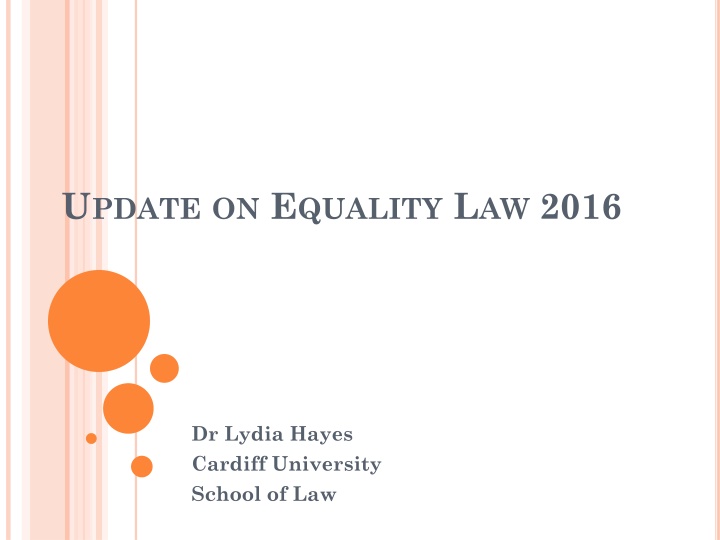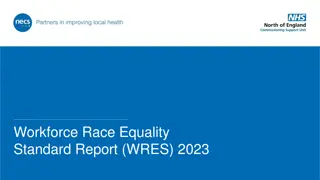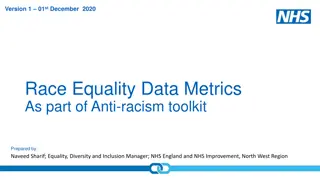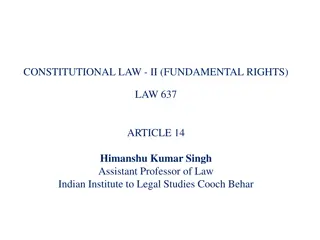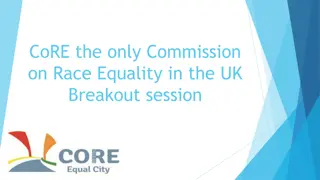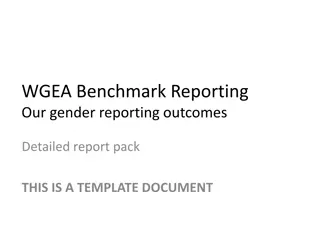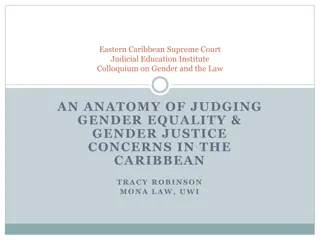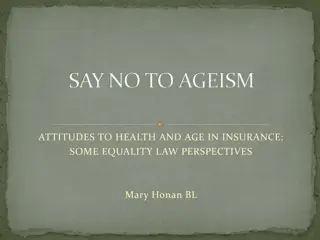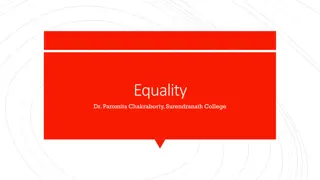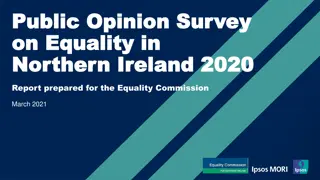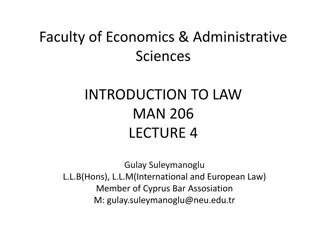UPDATE ON EQUALITY LAW 2016
In 2016, Equality Law faced challenges amidst legal unknowability due to Brexit, economic difficulties, shifting political opinion, and rising inequality and intolerance. Key cases like Olaigbe v. Taiwo shed light on discrimination based on migration status. The workplace context saw social changes impact dynamics, with issues such as Brexit bullying and post-referendum racism being highlighted.
Download Presentation

Please find below an Image/Link to download the presentation.
The content on the website is provided AS IS for your information and personal use only. It may not be sold, licensed, or shared on other websites without obtaining consent from the author.If you encounter any issues during the download, it is possible that the publisher has removed the file from their server.
You are allowed to download the files provided on this website for personal or commercial use, subject to the condition that they are used lawfully. All files are the property of their respective owners.
The content on the website is provided AS IS for your information and personal use only. It may not be sold, licensed, or shared on other websites without obtaining consent from the author.
E N D
Presentation Transcript
UPDATE ON EQUALITY LAW 2016 Dr Lydia Hayes Cardiff University School of Law
KEY CASES AND DEVELOPMENTS Olaigbe v Taiwo [2016] UKSC 31 Unite v Nailard UKEAT/0300/15 (September 2016) Brierley and others v Asda stores Reynolds v CFLIS [2015] EWCA Civ 439 UNISON v Lord Chancellor [2016] 1 CMLR 25 Essop v Home Office [2015] EWCA Civ 609 Naeem v Secretary of State for Justice [2016] ICR 289
EQUALITY LAW CONTEXT 2016 Legal unknowability (Brexit?) Economic difficulties Shifting political opinion, public mood INEQUALIY AND INTOLERANCE Media: mainstream, press and social media Race / religious abuse up 41% in one month following referendum Tory government Jo Cox: Murder of an MP Disability hate crime prosecutions up 40% (disabled children twice as likely as non-disabled children to be victims of crime)
OLAIGBEV TAIWO No protection from discrimination because of migration status Immigration status not to be equated with nationality Conduct would have been unlawful if motivated by claimants race but was rather bad treatment because of migrant status Less favourable treatment because of race? (nationality or colour) Migrant workers status made her vulnerable dependent on Olaigbe for employment and residence in UK
OLAIGBEVTAIWO Baroness Hale Parliament could have chosen to include immigration status in the list of protected characteristics, but it did not do so. There may or may not be good reasons for this certainly, Parliament would have had to provide specific defences to such claims, to cater for the fact that many people coming here with limited leave to remain, or entering or remaining here without any such leave at all, are not allowed to work and may be denied access to certain public services. ... This is not because these appellants do not deserve a remedy for all the grievous harms they have suffered. It is because the present law, although it can redress some of those harms, cannot redress them all.
WORKPLACECONTEXT How are social changes experienced in workplaces? New injection of politics into workplaces an opportunity as well as a threat. Brexit bullying potential religion/belief discrimination claim? (philosophical belief) Post-referendum racism . 100 s incidents logged by police, murder of Arek Jozwik, factory worker, August Direct discrimination (because of); discrimination by perception; discrimination by association Workplace banter BEWARE! Grievance procedures safe means to raise complaints Training and fair disciplinary action (employer liability defence)
NAILARDV UNITE Liability of unions extends to actions of stewards / reps Bullying and harassment of a paid official by stewards in a manner which also amounted to sexual harassment was the union liable? Section 109 Equality Act 2010 1) were stewards employees of union? No 2) were stewards agents of union? Yes Section 109(2) Anything done by an agent for a principal with the authority of the principal must be treated as also done by the principal ... Section 109(3) It does not matter whether that thing is done with employers or principals knowledge or approval
NAILARDV UNITE Potential defence Section 109(4) In proceedings against A s employer (B) in respect of anything alleged to have been done by A in the course of A s employment it is a defence for B to show that B took all reasonable steps to prevent A A) from doing that thing B) from doing anything of that description following Reynolds v CLFIS EAT found ET had applied wrong test with respect of failure of paid officials to take action against stewards were they also engaged in discrimination or exacerbating harassment? Remitted to new ET. Reliance on Reynolds what were the facts in the mind of the aledged discriminators Education training policies using internal disciplinary mechanisms.
BRIERLEYV ASDASTORES Equal pay law mass claims to reshape the private sector? Equal value claim Substantial pay differences Section 79 equality act ... and single source (EU) Same employer, different establishment but common terms apply (Asda submitted that differences in hourly pay provided evidence that there were no common terms) Employees at Asda stores may use employees at Asda depots as comparators. Implications 130,000 retail staff working for Asda
PARTICULARDISADVANTAGE Homer v Chief Constable of West Yorkshire [2012] UKSC 15 Baroness Hale: The new formulation was not intended to make it more difficult to establish indirect discrimination: quite the reverse ... It was intended to do away with the need for statistical comparisons where no statistics might exist. It was intended to do away with the complexities involved in identifying those who could comply and those who could not and how great the disparity had to be. Now all that is needed is a particular disadvantage when compared with other people who do not share the characteristic in question.
PARTICULARDISADVANTAGE Naeem v Secretary of State for Justice Essop v Home Office Length of service criteria prison chaplains Muslim chaplains appointed from 2002 therefore on average lower pay than Christian chaplains. What is the correct pool of comparison all chaplains or all chaplains employed since 2002? (EAT) If indirectly discriminatory can this be justified? (ET) CoA Applying Essop. What is the reason for the PCP complained of? Muslims had not been employed for as long therefore non- discriminatory. However? - was length of service criterion necessary or were there less discriminatory means BME candidates more likely to fail exams needed for promotion in civil service. Indirect discrimination on grounds of race ? Statistical evidence alone appears insufficient. Court of Appeal asking for the reason why a causal connection between disadvantage and the protected characteristic. This is new ....
UNISONVLORDCHANCELLOR Particular disadvantage Particular disadvantage Immediate impact 80% reduction in number of sex discrimination claims Research finds only 40% of employers have paid a tribunal judgment in full within 18 months Fee remission system removes difference between Employment Tribunals and County Courts (complex system of 3 levels of remission welfare benefits, low wages, partial fee remission) Fees unlawful and discriminatory = held insufficient evidence of any individual being unable to bring a claim because of cost
UNISONVLORDCHANCELLOR Cost alone cannot justify discriminating against certain categories of persons. Underlying rationale for tribunal fees: Ought to be a relationship between fee levels and degree of demand on tribunal resources. That was not invoking cost or budgetary considerations . Legitimate to change tribunal fees, graduated system reflecting degree to which tribunal resources engaged was about economic efficiency which was regularly accepted as justification. Access to Justice Principle of effectiveness: Access to an effective remedy Procedural conditions affecting entitlement to bring claims are unobjectionable according to ECtHR jurisprudence providing they do not render virtually impossible or excessively difficult the exercise of rights by EU law. Article 6 not absolute right to a Court subject to limitation, access regulated by State. Requirement to pay fees not a restriction on right of access Amount of fees in light of particular circumstances including ability to pay was a material factor relating to right of access
Other issues: EHRC Pregnancy and Maternity discrimination UN Report on United Nations Convention on Rights of Persons with Disability
